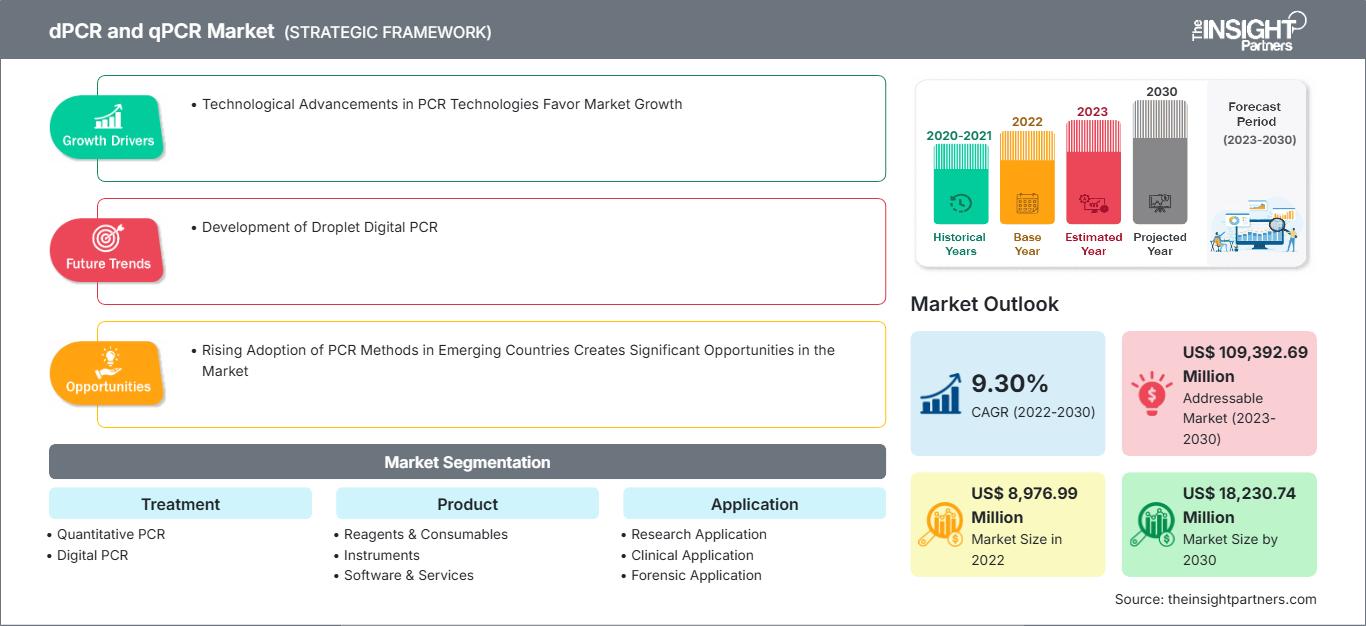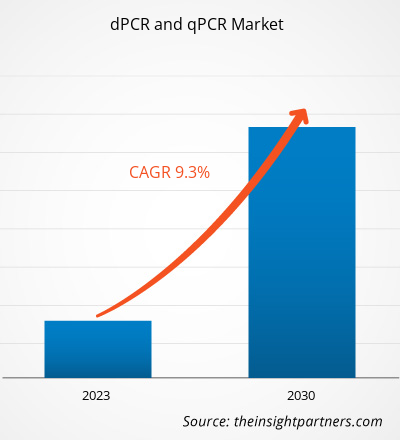dPCR 및 qPCR 시장 규모는 2022년 89억 7,699만 달러에서 2030년에는 182억 3,074만 달러에 이를 것으로 예상됩니다. 이 시장은 2022년부터 2030년까지 연평균 9.30%의 성장률을 기록할 것으로 예상됩니다. 드롭릿 디지털 PCR의 개발은 시장의 주요 트렌드로 남을 것으로 예상됩니다.
dPCR 및 qPCR 시장 분석
분자생물학에서 핵산 정량은 정량 PCR(qPCR)과 디지털 PCR(dPCR)이라는 두 가지 필수 기술에 의해 촉진됩니다. PCR 기술의 정확성, 효율성, 그리고 경제성을 향상시키는 지속적인 혁신과 데이터 분석 및 해석 개선을 위한 AI 및 머신러닝의 통합으로 인해 이 시장은 성장할 것으로 예상됩니다. 시장의 주요 기업으로는 Agilent Technologies Inc., QIAGEN NV, Roche Diagnostics, Thermo Fisher Scientific Inc., Bio-Rad Laboratories, Inc.가 있습니다. 질병 유병률 증가, 기술 발전, 그리고 연구 개발 확대로 인해 dPCR 및 qPCR에 대한 수요가 크게 증가할 것으로 예상됩니다. 그럼에도 불구하고, 과도한 비용과 기술적 제약과 같은 어려움에도 불구하고, 이 시장은 특히 개발도상국에서 발전과 성장에 대한 수익성 있는 전망을 제공합니다.
dPCR 및 qPCR 시장 개요
재조합 단백질 합성과 증폭 및 정량화를 위한 PCR 기술을 포함하는 재조합 DNA 기술 분야에서 유전자 합성은 가장 널리 알려진 기술입니다. 2021년, Mercia는 생명공학 및 제약 산업에 유전자를 공급하는 합성 생물학 스타트업인 Camena Bioscience에 1,000만 달러 규모의 시리즈 A 투자 유치를 주도했습니다. Camena Bioscience는 추가 자금을 통해 사업을 성장시키고 혁신적인 DNA 합성 플랫폼인 gSynth를 지속적으로 개발할 것입니다. 기술 플랫폼과 기타 관련 자원은 회사의 유전자 합성 개발을 가속화합니다. 또한, 기업들은 유전자 합성 개선을 위한 연구 개발 자금을 확대해 왔습니다. 2020년, EVONETIX LTD는 고충실도, 신속하고 확장 가능한 유전자 합성을 위한 데스크톱 플랫폼을 개발하는 합성 생물학 스타트업으로 시리즈 B 투자 라운드를 완료했다고 발표했습니다. 이번 라운드에서 EVONETIX는 신규 투자자인 포레사이트 캐피털(Foresite Capital)의 주도로 미화 3천만 달러(2,300만 파운드)를 유치했습니다. 라이징 타이드 펀드(Rising Tide Fund)와 문명화 벤처스(Civilization Ventures) 외에도 드레이퍼 에스프리(Draper Esprit), DCVC(데이터 콜렉티브), 모닝사이드 그룹(Morningside Group), 프로비던스 인베스트먼트 컴퍼니(Providence Investment Company), 캠브리지 컨설턴트(Cambridge Consultants Ltd.) 등이 이번 라운드에 참여했습니다. 이처럼 정부 기관의 투자 증가는 글로벌 유전자 합성 시장 확대를 뒷받침하고 있습니다.
이 보고서의 일부, 국가 수준 분석, Excel 데이터 팩을 포함하여 모든 보고서에 대한 사용자 정의를 무료로 받을 수 있을 뿐만 아니라 스타트업 및 대학을 위한 훌륭한 제안 및 할인을 이용할 수 있습니다
dPCR 및 qPCR 시장: 전략적 통찰력

-
이 보고서의 주요 주요 시장 동향을 확인하세요.이 무료 샘플에는 시장 동향부터 추정 및 예측에 이르기까지 데이터 분석이 포함됩니다.
dPCR 및 qPCR 시장 성장 동력 및 기회
PCR 기술의 기술적 발전은 시장 성장을 촉진합니다
대부분의 분자생물학 연구실에서 중합효소 연쇄 반응(PCR)은 유전형 분석, 클로닝 및 단일 뉴클레오타이드 변이 분석을 위해 특정 DNA 가닥을 증폭하는 데 사용되는 강력하고 거의 보편적인 기술입니다. 또한 대부분의 차세대 시퀀싱(NGS) 준비의 기반이 됩니다. 기술 발전으로 다양한 종류의 PCR 기술이 탄생하고 있습니다. 현재 PCR 기술은 분자 진단을 용이하게 하고 가속화할 수 있는 몇 가지 비전통적인 용도로 연구되고 있습니다. 특히 디지털 및 실시간 PCR 기술은 법의학 수사 지원, 바이러스 및 박테리아 식별, 질병 진단에 활용되고 있습니다.
또한, 연구진은 나노물질을 사용하여 검사 시간을 단축하려고 노력하고 있습니다. 한국과학기술연구원(KIST, 원장 윤석진)의 지능감지 안전증강시스템 연구단은 2023년 3월 초고속 PCR 기술 개발을 발표했습니다. 김상경 박사, 정승원 박사 연구팀은 광열 나노소재를 이용한 초고속 PCR 기술을 통해 기존 기술 대비 검사 시간을 절반으로 단축했습니다. 이 새로운 기술은 5분 만에 완료되며, 기존 검사법과 동등한 진단 성능을 보입니다. 따라서 dPCR 및 qPCR 시장의 성장은 PCR 기술의 발전에 힘입어 이루어지고 있습니다.
신흥국의 PCR 도입 증가는 시장에 중요한 기회를 창출합니다.
PCR과 같은 분자 기술은 최근 진단 도구로서 발전해 왔습니다. 이 기술은 의료 전문가들이 광범위한 감염성 질환을 정확하게 진단할 수 있게 해주기 때문에 필수적인 연구 및 진단 도구로 여겨집니다. PCR을 통해 단일 DNA 가닥은 수백만 개의 자기 복제본을 생성할 수 있습니다. 또한 조기 질병 진단을 가능하게 하여 질병 관리에 필수적입니다.PCR은 실험실 간에 비교할 수 있는 일관된 결과를 생성하기 때문에 널리 받아들여지고 있습니다.PCR 방법은 개발도상국에서 점점 더 인기를 얻고 있습니다.세계보건기구(WHO)는 개발도상국의 PCR 실험실 설립에 대한 세계보건기구 보고서(2016)에 따르면 11개 WHO 동남아시아 회원국에 PCR 실험실을 설립하기 위해 필요한 기술 지원을 제공하고 있습니다.이 실험실은 최고 수준의 의료 서비스 제공을 지원할 것입니다.이러한 PCR 실험실은 필요에 따라 디지털 PCR(dPCR), 멀티플렉스 PCR, 실시간 PCR, 현장 PCR 및 역전사 PCR(RT-PCR)을 포함한 다양한 PCR 기술을 도입했습니다. 사용 편의성, 속도, 질병 스크리닝에서의 높은 특이성과 임상 미생물학, 바이러스학, 기생충학, 생명공학 및 관련 분야에서의 응용 분야 확대로 인해 개발도상국의 dPCR 및 qPCR 시장은 향후 몇 년 동안 크게 성장할 것으로 예상됩니다.
dPCR 및 qPCR 시장 보고서 세분화 분석
dPCR 및 qPCR 시장 분석 도출에 기여한 주요 부문은 치료, 제품, 응용 분야 및 최종 사용자입니다.
- 치료를 기준으로 dPCR 및 qPCR 시장은 정량 PCR(qPCR)과 디지털 PCR(dPCR)로 세분화됩니다. 디지털 PCR(dPCR) 부문은 2022년에 가장 큰 시장 점유율을 기록했습니다.
- 제품별로 시장은 장비, 소프트웨어 및 서비스, 시약 및 소모품으로 분류됩니다. 시약 및 소모품은 소모품 부문은 2022년 시장 점유율에서 가장 큰 비중을 차지했습니다.
- 응용 분야별로 dPCR 및 qPCR 시장은 연구 분야, 임상 분야, 법의학 분야로 구분됩니다. 임상 분야는 2022년에 가장 큰 시장 점유율을 차지했습니다.
- 최종 사용자별로는 제약 및 생명공학 회사, 병원 및 진단 센터, 법의학 연구소, 연구실 및 학술 기관, 임상 연구 기관으로 구분됩니다. 병원 및 진단 센터 부문은 2022년에 상당한 시장 점유율을 차지했습니다.
지역별 dPCR 및 qPCR 시장 점유율 분석
dPCR 및 qPCR 시장 보고서의 지리적 범위는 주로 북미, 아시아 태평양, 유럽, 중동 및 아프리카, 중남미의 5개 지역으로 나뉩니다.
미국, 캐나다, 멕시코는 북미 dPCR 및 qPCR 시장 부문을 구성합니다. 미국과 캐나다는 북미 지역의 주요 생명공학 시장에서 가장 큰 시장 점유율을 차지하고 있습니다. 주요 시장 참여자들의 존재, 생물 분석 장비 제조업체와 PCR 기업의 혁신 제품 수요 증가, 그리고 여러 학계 및 연구 기관의 광범위한 연구 개발은 모두 북미 시장 성장에 기여하고 있습니다. 의료 분야에서 첨단 기술 활용에 대한 중요성이 커지고, 정밀 의학 발전을 위한 공공 및 민간 부문의 노력, 그리고 공공 및 민간 부문의 게놈 연구에 대한 상당한 자금 지원은 북미 dPCR 및 qPCR 시장의 성장을 촉진하고 매출 창출을 크게 증가시킬 것으로 예상됩니다. 더욱이, 북미 연구진들은 북미 지역의 성장과 글로벌 시장 지배력에 부합하는 과학적 발전을 이루어 왔습니다.
dPCR 및 qPCR 시장 지역별 통찰력
The Insight Partners의 분석가들은 예측 기간 동안 dPCR 및 qPCR 시장에 영향을 미치는 지역별 동향과 요인을 면밀히 분석했습니다. 이 섹션에서는 북미, 유럽, 아시아 태평양, 중동 및 아프리카, 그리고 중남미 지역의 dPCR 및 qPCR 시장 부문과 지역별 분포도 살펴봅니다.
dPCR 및 qPCR 시장 보고서 범위
| 보고서 속성 | 세부 |
|---|---|
| 시장 규모 2022 | US$ 8,976.99 Million |
| 시장규모별 2030 | US$ 18,230.74 Million |
| 글로벌 CAGR (2022 - 2030) | 9.30% |
| 이전 데이터 | 2020-2021 |
| 예측 기간 | 2023-2030 |
| 다루는 세그먼트 |
By 치료
|
| 포함된 지역 및 국가 |
북미
|
| 시장 선도 기업 및 주요 회사 프로필 |
|
dPCR 및 qPCR 시장 참여자 밀도: 비즈니스 역학에 미치는 영향 이해
dPCR 및 qPCR 시장은 소비자 선호도 변화, 기술 발전, 그리고 제품 효능에 대한 인식 제고 등의 요인으로 인한 최종 사용자 수요 증가에 힘입어 빠르게 성장하고 있습니다. 수요 증가에 따라 기업들은 제품 및 서비스 확장, 소비자 니즈 충족을 위한 혁신, 그리고 새로운 트렌드를 적극 활용하며 시장 성장을 더욱 가속화하고 있습니다.

- 을 얻으세요 dPCR 및 qPCR 시장 주요 주요 플레이어 개요
dPCR 및 qPCR 시장 뉴스 및 최근 동향
dPCR 및 qPCR 시장은 1차 및 2차 연구 이후 수집된 정성 및 정량 데이터를 통해 평가되며, 여기에는 주요 기업 간행물, 협회 데이터, 데이터베이스가 포함됩니다. dPCR 및 qPCR 시장의 몇 가지 동향은 다음과 같습니다.
- QIAGEN NV는 바이오제약 산업에서 세포 및 유전자 치료제 개발을 위해 디지털 PCR(dPCR) 제품 확장을 발표했습니다. QIAGEN은 Niba Labs와 협력하여 바이오제약 고객에게 맞춤형 디지털 PCR 분석 설계 서비스를 제공하고, 세포 용해물부터 다양한 혈청형에 대한 바이러스 역가의 절대적이고 정확한 정량화까지 표준화된 워크플로우를 지원하는 새로운 CGT 바이러스 벡터 용해 키트(CGT Viral Vector Lysis Kit)도 출시했습니다. (출처: QIAGEN NV, 보도자료, 2023년 7월)
- Roche와 그 자회사 TIB Molbiol은 최근 원숭이두창 바이러스 관련 우려에 대응하여 세 가지 고유한 LightMix 모듈러 바이러스 키트를 개발했습니다. 지난 2주 동안 원숭이두창 바이러스의 여러 집단 발생이 보고되었는데, 이 지역들은 해당 바이러스가 흔하지 않은 지역입니다. (출처: Roche, 보도자료, 2023년 5월)
dPCR 및 qPCR 시장 보고서 범위 및 결과
“dPCR 및 qPCR 시장 규모 및 예측(2020~2030년)” 보고서는 다음 영역을 포괄하는 시장에 대한 자세한 분석을 제공합니다.
- 범위에 포함된 모든 주요 시장 부문에 대한 글로벌, 지역 및 국가 수준의 dPCR 및 qPCR 시장 규모 및 예측
- dPCR 및 qPCR 시장 동향 및 추진 요인, 제약 및 주요 기회와 같은 시장 역학
- 자세한 PEST/포터의 5가지 힘 및 SWOT 분석
- 주요 시장 동향, 글로벌 및 지역 프레임워크, 주요 업체, 규정 및 최근 시장 동향을 포괄하는 dPCR 및 qPCR 시장 분석
- 시장 집중도, 히트맵 분석, 주요 업체 및 dPCR 및 qPCR 시장의 최근 동향을 포괄하는 산업 환경 및 경쟁 분석
- 자세한 회사 프로필
- 과거 분석(2년), 기준 연도, CAGR을 포함한 예측(7년)
- PEST 및 SWOT 분석
- 시장 규모 가치/거래량 - 글로벌, 지역, 국가
- 산업 및 경쟁 환경
- Excel 데이터세트
최근 보고서
사용 후기
구매 이유
- 정보에 기반한 의사 결정
- 시장 역학 이해
- 경쟁 분석
- 고객 인사이트
- 시장 예측
- 위험 완화
- 전략 기획
- 투자 타당성 분석
- 신흥 시장 파악
- 마케팅 전략 강화
- 운영 효율성 향상
- 규제 동향에 발맞춰 대응






















 무료 샘플 받기 - dPCR 및 qPCR 시장
무료 샘플 받기 - dPCR 및 qPCR 시장